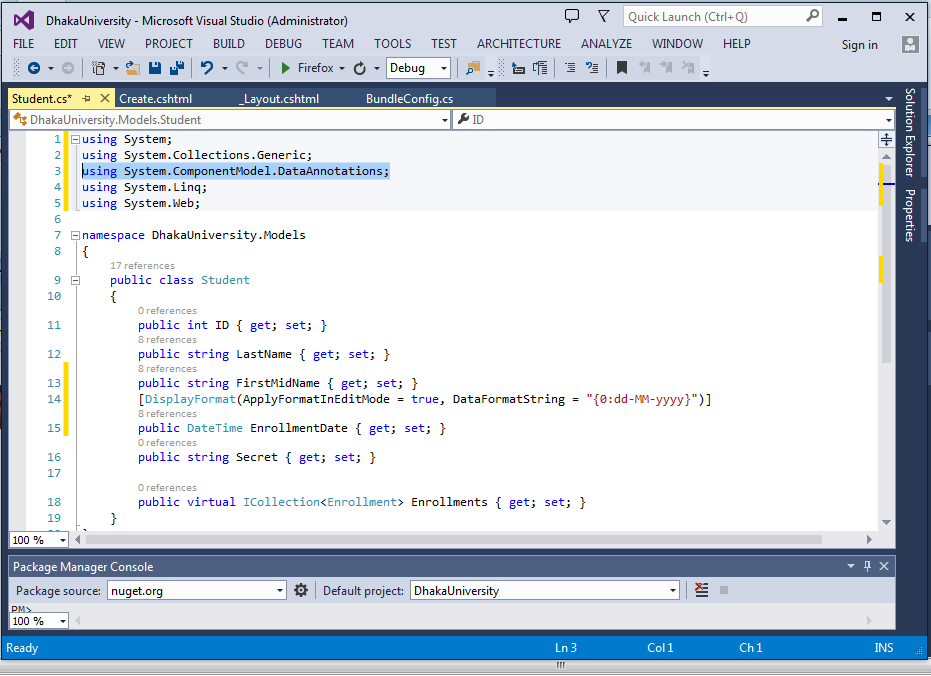
}).Where(n => n.Campus = _selectedCampus).OrderBy(n => n. Mia1aSec1FayRepository.Get().Select(n => new Mia1aSec1FayExportĬreditsBeforeSchoolYear = n.CreditsBeforeSchoolYear,ĬreditsDuringSemester1 = n.CreditsDuringSemester1,ĮligibleFayMeetingGoal = n.EligibleFayMeetingGoal This is the query result set the user wishes to export to file. This is what I currently have: public ActionResult ExportToExcel(string _selectedCampus) If you're applying localization in your applications, annotations are a great mechanism to localize the labels for your properties and define how the data will be formatted and displayed (e.g., date formats, numeric formats). It uses the data annotation attributes to define validation rules and UI styles. I know that I can load the worksheet cells through another method than LoadFromCollection, but I was wondering if it is possible to still use LoadFromCollection and use the model's Display(Name()) annotations. ABP Framework automatically localizes the display name of a form element. DataType DisplayName DisplayFormat Required ReqularExpression Range. This article will focus on using DataAnnotations (in the System.ComponentModel.
#DATA ANNOTATIONS DISPLAY NAME CODE#
One is using simple attributes called DataAnnotations, and the second is using Code First’s Fluent API, which provides you with a way to describe configurations imperatively, in code. In my model, I use the annotations, and they appear as intended on the View pages, but they do not carry over to the exported Excel file when the user triggers the export function. Data Annotation is used for Data validation. Code First gives you two ways to add these configurations to your classes. Item.CustomerName = _firstNames( rnd.(0, _firstNames.Length)) & " " + _lastNames( rnd.(0, _lastNames.In my MVC 5 site, I have an Export to Excel function that is stable, but the users have requested that I make the column headers "user friendly." Public Shared Function GetSampleData( ByVal cnt As Integer) As BindingList( Of Data) Public Property Age As Integer ' create some sample data Public Property Frequency As Double ' auto-generated "Age" column will allow values in the predefined Public Property CustomerID As Integer ' auto-generated "Frequency" column will show values formatted as percentages Public Property CustomerName As String ' auto-generated CustomerID column will be invisible. Display (Name 'Add Comments') which is using this namespace: using OR. DisplayName Defines the text we want used on form fields and validation messages StringLength Defines a maximum length for a string field Range Gives a. However I would say to stick with the better and more flexible -> Display (Name. ' This column also requires non-empty string with minimal length at least 2 symbols. DisplayName Defines the text we want used on form fields and validation messages. ' auto-generated CustomerName column header will show "Customer" DataAnnotations is used to configure your model classes, which will highlight the most commonly needed configurations. Item.CustomerName = _firstNames + " " + _lastNames Public static BindingList GetSampleData( int cnt) auto-generated "Age" column will allow values in the predefined auto-generated "Frequency" column will show values formatted as percentages auto-generated CustomerID column will be invisible. resx file with a culture name, Visual Studio wont generate the class file. resx file with a culture name (for example .resx). This column also requires non-empty string with minimal length at least 2 symbols. Thats usually not what you want with ASP.NET Core. auto-generated CustomerName column header will show "Customer" The following code example shows how data annotation feature works in WinForms FlexGrid control. The data annotation validation attributes are used as validation rules in FlexGrid operations. Indicates whether a data field is editable.ĭenotes one or more properties that uniquely identify an entity.

Specifies the column that is displayed in the referred table as a foreign-key column.
.png)
Specifies how data fields are displayed and formatted by ASP.NET Dynamic Data. Provides a general-purpose attribute that lets you specify localizable strings for types and members of entity partial classes. Specifies that an entity member represents a data relationship, such as a foreign key relationship. Cilck here for complete list of DataAnnotation attributes. Listed below are some of the major annotation attributes that are supported in FlexGrid control. Note: The C1FlexGrid supports the annotations defined in.


 0 kommentar(er)
0 kommentar(er)
